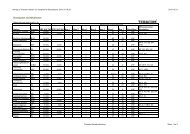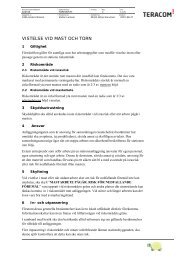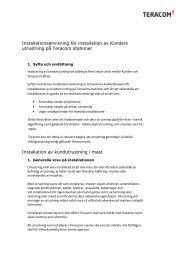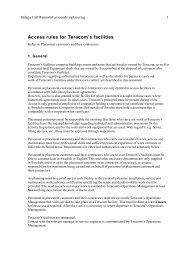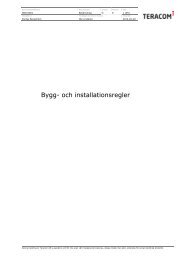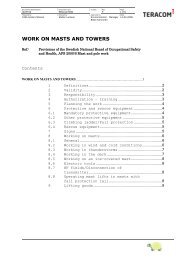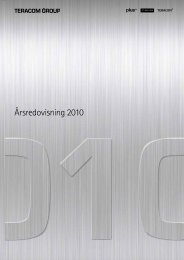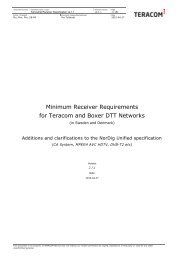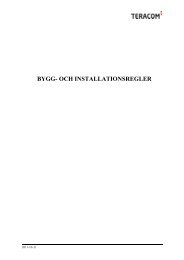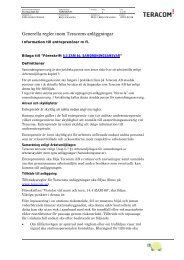Annual and Sustainability Report 2011 - Teracom
Annual and Sustainability Report 2011 - Teracom
Annual and Sustainability Report 2011 - Teracom
You also want an ePaper? Increase the reach of your titles
YUMPU automatically turns print PDFs into web optimized ePapers that Google loves.
the Group conducts an impairment test, i.e. an assessment of the asset's<br />
recoverable amount. Recoverable amount refers to the higher of an asset's<br />
fair value, less sales expenses, <strong>and</strong> its value-in-use. Value-in-use is calculated<br />
as the present value of expected future cash flows that the asset is<br />
expected to generate. The asset is written down by the amount to which the<br />
asset's carrying amount exceeds the recoverable amount. When determining<br />
write-down requirements, the assets are grouped into cash-generating<br />
units. A cash-generating unit is the smallest group of assets generating cash<br />
flows that are in all material aspects independent of cash flows from other<br />
assets or groups of assets. In addition, the Group conducts an annual review<br />
of intangible assets with uncertain useful lives <strong>and</strong> intangible assets that are<br />
not yet available for use. An assessment of whether there are any indications<br />
of impairment is carried out at least once per year.<br />
Leases<br />
A lease is classified as a financial lease if it transfers substantially all of the<br />
risks <strong>and</strong> rewards incident to ownership from the lessor to the lessee. All other<br />
leases are classified as operating leases.<br />
<strong>Teracom</strong> as lessor<br />
Leases where the lessor retains substantially all of the risks <strong>and</strong> rewards incident<br />
to ownership are classified as operating leases. The Group's income from<br />
operating leases primarily comes from rental agreements related to co-locations<br />
in the Group's masts. Any leasing income that arises is allocated to the<br />
proper period <strong>and</strong> revenue is recognized linearly over the lease term. However,<br />
any costs that arise, including depreciation, are expensed as occurred. Depreciation<br />
is in accordance with the rules for each type of asset, respectively.<br />
<strong>Teracom</strong> as lessee<br />
Leasing agreements pertaining to fixed assets, where the Group retains substantially<br />
all of the risks <strong>and</strong> rewards incident to ownership, are classified as<br />
financial leases. At the inception of the lease, financial leases are reported in<br />
the balance sheet at the leased asset's fair value or the present value of the<br />
minimum lease payments (whichever is lower). Fixed assets obtained through<br />
financial lease agreements are primarily vehicles, which are depreciated over<br />
the asset's useful life or the term of the lease (whichever is shorter). Financial<br />
lease payments are appropriated between financial expenses, interest <strong>and</strong> the<br />
reduction (amortization) of the outst<strong>and</strong>ing financial liability, so as to produce<br />
a constant periodic rate of interest on the remaining balance of the liability.<br />
The corresponding payment obligations, less the deduction of financial<br />
expenses, are included in the balance sheet items: Liabilities to credit institutions<br />
(long-term <strong>and</strong> short-term financial liabilities, respectively). Financial<br />
expenses are recognized in the income statement.<br />
For operating leases, the lease payments are recognized as an expense in<br />
the income statement over the lease term on a straight-line basis.<br />
Financial instruments<br />
Financial instruments are any type of contract that gives rise to a financial<br />
asset, financial liability or one's own capital instrument in another company.<br />
For the Group, financial instruments are comprised of the following: cash<br />
equivalents, interest-bearing receivables, accounts receivable, accounts payable,<br />
borrowings <strong>and</strong> derivatives.<br />
Classification of financial assets<br />
Management determines the initial classification of the financial asset. The<br />
purpose of the acquisition of the financial asset determines its classification.<br />
a) Financial assets valued at fair value via the income statement<br />
A financial asset is transferred to this category if it was acquired primarily to<br />
be sold in the short term. Derivatives are classified as held for trading, provided<br />
that they are not identified as hedges, which are valued at fair value via<br />
the income statement. Derivatives are only used for the purpose of managing<br />
the Group’s electricity, currency <strong>and</strong> interest rate risks.<br />
b) Loan receivables <strong>and</strong> accounts receivable<br />
Loan receivables <strong>and</strong> accounts receivable are financial assets with fixed or<br />
determinable payments. The receivables are reported as current assets, with<br />
the exception of receivables maturing more than 12 months after the balance<br />
sheet date, which are classified as non-current assets. The Group's cash<br />
equivalents, accounts receivable <strong>and</strong> loan receivables are included in this<br />
category. Cash equivalents consist of cash, bank balances <strong>and</strong> other current<br />
investments with high liquidity <strong>and</strong> a maturity of no more than three months<br />
that can be easily converted to a known cash amount <strong>and</strong> are only exposed to<br />
negligible risk of fluctuation in value.<br />
c) Investments held until maturity<br />
Investments held to maturity are non-derivative financial assets with fixed or<br />
determinable payments <strong>and</strong> fixed maturity that the company management<br />
has the positive intention <strong>and</strong> ability to hold to maturity.<br />
Recognition <strong>and</strong> measurement of financial assets<br />
Acquisitions <strong>and</strong> sales of financial assets are reported on the transaction date,<br />
i.e. the date the Group undertakes a binding commitment to buy or sell the<br />
asset. Financial assets are reported in the balance sheet when the Group has<br />
transferred the material risks <strong>and</strong> rewards associated with the transaction <strong>and</strong><br />
the counterpart has an obligation to pay. A financial asset is removed from<br />
the balance sheet when the right to receive cash flows from the asset has<br />
expired or was transferred <strong>and</strong> all risks <strong>and</strong> rewards associated with ownership<br />
were transferred from the Group.<br />
a) Financial assets valued at fair value via the income statement are valued at<br />
fair value on a continual basis.<br />
b) Loan receivables <strong>and</strong> accounts receivable are reported initially at fair value<br />
<strong>and</strong> thereafter at amortized cost less any deductions for impairment provisions.<br />
Impairment provisions are made when it is apparent that the company<br />
will not be able to collect the total outst<strong>and</strong>ing amount in accordance<br />
with the original terms. Group companies with pay TV operations, which<br />
have end consumers as part of their customer base, make provisions in<br />
accordance with a pre-determined ladder that has been adapted to the<br />
conditions of each geographic market. Group companies with network<br />
activities, which do business with other companies, make provisions based<br />
on an individual assessment of each customer <strong>and</strong> receivable. The change<br />
in the provision is reported in the income statement as a cost of sales.<br />
c) Investments held to maturity are reported initially at fair value plus transaction<br />
costs. They are then reported at amortized cost, which is equal to<br />
the present value of the remaining cash flows using the effective interest<br />
method.<br />
Derivative instruments <strong>and</strong> hedging<br />
The Group's finance policy only allows derivatives to decrease an underlying<br />
exposure. Using a derivative for trading or any purpose other than hedging is<br />
not allowed. Given this restriction, the Group only holds the following types<br />
of derivatives at the end of the year:<br />
- Currency derivatives held to hedge future payments <strong>and</strong> accounts payable<br />
in foreign currency. These derivatives do not qualify for hedge accounting.<br />
- A portfolio with electricity derivatives to hedge Swedish electricity price risk<br />
which constitute a cash flow hedge.<br />
- A loan in SEK with a variable interest rate that was converted to a DKK<br />
loan with a variable interest rate using a currency interest rate swap, which<br />
should hedge the currency risk in the net investment in the Danish subsidiary,<br />
<strong>Teracom</strong> A/S.<br />
- A fixed interest rate swap that hedges the interest rate risk in parts of the<br />
above-mentioned loans with variable interest rates.<br />
Derivative instruments are reported in the balance sheet at the contract<br />
date <strong>and</strong> at fair value, both initially <strong>and</strong> following subsequent revaluations.<br />
The method for reporting gain or loss depends on whether the derivative<br />
instrument was designated as a hedging instrument <strong>and</strong> the nature of the<br />
hedged item.<br />
When the hedge is entered into, the Group documents the relationship<br />
between the hedging instrument <strong>and</strong> the hedged items as well as the company's<br />
objective for its risk management <strong>and</strong> the risk management strategy<br />
for the hedge. The Group also documents, even when the hedge is entered<br />
into on an ongoing basis, its assessment of whether the derivatives used for<br />
the hedging transactions are expected to be very effective at neutralizing<br />
changes in fair value or cash flows attributable to the hedged risk. Changes<br />
in the hedge reserve are reported under Other comprehensive income in the<br />
consolidated income statement.<br />
Cash flow hedging<br />
The effective portion of the changes in fair value of a derivative instrument<br />
designated as a cash flow hedge is reported under Other comprehensive<br />
income. The gain or loss attributable to the ineffective portion is reported<br />
directly under net financial income in the income statement. For the Group<br />
this refers to the hedging of electricity price risk <strong>and</strong> hedging of interest rate<br />
risk via interest rate swaps.<br />
69



